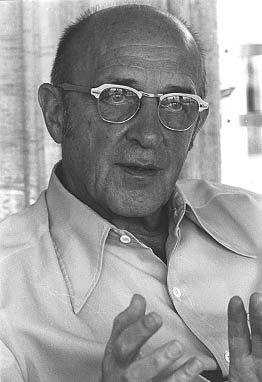Personality Course - Carl Rogers
ROGERS AND HIS PERSON CENTERED THEORY
Carl Rogers, probably the best-known spokesperson for humanistic psychology, was one of the first members of the Association of Humanistic Psychology. Like other humanists, his ideas built on Alfred Adler’s belief that people have a fundamental tendency to develop in healthy directions.
BIOGRAPHY

source
Carl R. Rogers was born in Oak Park, Illinois (near Chicago), on January 8, 1902. The family valued hard work and fundamentalist Christianity, adhering to strict rules of behavior. They lived in a farm so the children did not encounter the temptations of close contact with others in the city or suburbs. This “gently suppressive family atmosphere” took its toll. Rogers and two siblings developed ulcers.
Rogers read at a fourth-grade level when he first entered school, and he loved to be alone and to read when he was growing up. As one might expect, his grades were always high. Rogers graduated from college in 1924 with a bachelor’s degree in history. Ironically, he had taken only one psychology course as an undergraduate. That summer he married his fiancée of nearly 2 years, Helen Elliot, a commercial artist, and they went to New York City, where they both entered graduate school. Carl and Helen had two children—David and Natalie.
In 1940, after 12 years at Rochester, Rogers and his family moved to Ohio, where he took his first academic appointment: full professor at Ohio State University. It is highly unusual for a faculty member to begin at the top academic rank, but Rogers had just published an influential book, Clinical Treatment of the Problem Child. In his lectures, he came to realize that his ideas about therapy were new, and he developed these ideas in another book, Counseling and Psychotherapy, which became a classic. It contained the first published verbatim transcript of a therapy case, opening this private process for study. His students learned not only in the classroom but also through practicum experience, which was revolutionary at the time.
In 1945 Rogers went to the University of Chicago to establish a new counseling center. An active and collegial atmosphere developed there, and during this time Rogers (1951) wrote another of his influential books, Client-Centered Therapy. In 1957 he accepted a joint appointment in psychology and psychiatry at the University of Wisconsin, where he found a competitive and non-supportive atmosphere that conflicted with his own humanistic convictions. He protested in 1963 by resigning his appointment in the Department of Psychology, retaining his position in psychiatry and suggesting a more humanistic approach to education.
His next move was away from university life. In 1964 he went to the Western Behavioral Sciences Institute in La Jolla, California. With others, he formed the Center for Studies of the Person, where he explored encounter groups and sensitivity training. According to one biographer, these group experiences were times of personal exploration and problems for Rogers (Cohen, 1997). His efforts turned, too, to international issues of peace and conflict resolution in Central America, South Africa, Northern Ireland, and the Soviet Union.
Rogers was a leader in professional organizations throughout his career. He served as president of the American Association for Applied Psychology (1944–1945) and of the American Psychological Association (1946–1947). He received two prestigious awards from the American Psychological Association: the Distinguished Scientific Contribution Award in 1956 (American Psychological Association, 1957) and the first Distinguished Professional Contribution Award in 1972 (American Psychological Association, 1973). He was the first (and as of 1987, only) psychologist to receive both honors. Rogers was also nominated for the Nobel Peace Prize in 1987. A little-known fact is that Rogers, like some other prestigious psychologists, was recruited by the Central Intelligence Agency to provide scientific advice and respectability during the tense international period following World War II.
Rogers died in 1987, at age 85, of a heart attack.
IN A NUTSHELL
- Carl Rogers offered a theory in which the person actively seeks higher development, motivated by the actualizing tendency rather than being passively determined by external forces.
- He described the characteristics of a healthy person, whom he called a fully functioning person.
- His client-centered therapy emphasized three factors that contribute to therapeutic success: unconditional positive regard, congruence, and empathic understanding.
- Rogers specified his theoretical constructs in ways that could be measured, so the theory could be empirically verified. Furthermore, he conducted groundbreaking research on the therapeutic process.
- Rogers elaborated on the change process in therapy, groups, education, and political conflict.
- One issue that troubles critics is whether people are innately good, to the extent that Rogers assumes.
Reference - Theories of Personality - Understanding Persons, Susan Cloninger, The Sage Colleges, 6th edition
This article is part of Personality Course series. If you miss previous articles, you can find them below.




I majored in psychology in college, so you are taking me right back to those days with this one! I'll have to check out the other posts in this series, as well. I may not be directly working in the field, but some of those principle still come in handy as a personal trainer. ;)
All these principles come in handy. I enjoyed tutoring this class, took me back to my college years too. Thanks for stopping by. I’m almost over with this course, I will post some personal conclusions soon. 😊